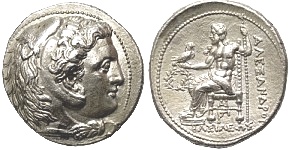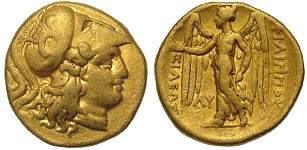Fine Coins Showcase
Antiquities Showcase
Show Empty Categories
Shop Search
Shopping Cart
My FORVM
Contact Us
About Forum
Shopping at Forum
Our Guarantee
Payment Options
Shipping Options & Fees
Privacy & Security
Forum Staff
Selling Your Coins
Identifying Your Coin
FAQs
zoom.asp
Home ▸ Catalog ▸ |Greek Coins| ▸ |Geographic - All Periods| ▸ |Persia & Mesopotamia||View Options:   | | | | | | Also included on this page are coins minted under Persian rule in other regions of the Persian Empire. |


This coin was an early posthumous issue, struck during the nominal rule the puppet kings Philip III (Alexander the Great's brother) & Alexander IV (Alexander the Great's son), under one of the Macedonian satraps in Babylon: Archon, Dokimos, or Seleukos I. The regent Perdiccas suspected Archon of colluding in the theft of Alexander's corpse and, in 321 B.C., sent Dokimos to replace him. Archon was defeated and died from battle wounds. Seleucus, made satrap by Perdiccas' rival Antipater, arrived in Babylon in October or November 320 B.C. and defeated Dokimos.SL111465. Gold stater, Price 3691, Müller Alexander 1271, NGC CH XF, strike 5/5, surface 4/5, fine style (6558782-001), weight 8.569 g, maximum diameter 17.8 mm, die axis 0o, Mesopotamia, Babylon (Hillah, Iraq) mint, early posthumous issue, c. 323 - 317 B.C.; obverse helmeted head of Athena right, crested Corinthian helmet ornamented with a coiled serpent, wearing pearl necklace, M behind; reverse Nike standing left, wreath in right hand, stylus in left hand, BAΣIΛEΩΣ (king) downward on left, AΛEΞANΔPOY (Alexander) downward on right, ΛY low inner right; ex Harlan J. Berk; NGC| Lookup; SOLD
Macedonian Kingdom, Philip III Arrhidaeus and Alexander IV, 323 - 317 B.C., Struck by Archon, Dokimos, or Seleukos I


This coin was struck under one of the Macedonian satraps in Babylon: Archon, Dokimos, or Seleukos I. Perdiccas suspected Archon of colluding in the theft of Alexander's corpse and, in 321 B.C., sent Dokimos to replace him. Archon was defeated and died from battle wounds. Seleucus, made satrap by Perdiccas' rival Antipater, arrived in Babylon in October or November 320 B.C. and defeated Dokimos.SH54774. Gold stater, Price P203, Müller Alexander P116, aEF, weight 8.564 g, maximum diameter 18.0 mm, die axis 90o, Mesopotamia, Babylon (Hillah, Iraq) mint, c. 323 - 317 B.C.; obverse head of Athena right in crested Corinthian helmet ornamented with Griffin; reverse BAΣIΛEΩΣ ΦIΛIΠΠOY, Nike standing left, wreath in right hand, facing head of Helios below left, [KY] below right; Struck under Archon, Dokimos, or Seleukos I, circa 323-318/7 BC.; SOLD
Macedonian Kingdom, Alexander the Great, 336 - 323 B.C.


SH26159. Gold stater, Price 3716a, aEF, flattened areas, weight 8.460 g, maximum diameter 18.6 mm, die axis 0o, Mesopotamia, Babylon (Hillah, Iraq) mint, 317 - 311 B.C.; obverse head of Athena right in crested Corinthian helmet; reverse BAΣIΛEΩΣ AΛEΞANΔPOY, Nike standing left holding wreath and ship's mast, HP monogram in lower right field, monogram within wreath in lower left; nicely centered, a couple flattened areas on obverse, the helmet above the eye and above the ear; SOLD
Persian Empire, Lydia, Anatolia, Darios I to Xerxes II, c. 485 - 420 B.C.


SH87857. Gold daric, Carradice Type IIIb, Group A/B (pl. XIII, 27); Meadows, Administration 321; BMC Arabia pl. XXIV, 26; Sunrise 24; Lydo-Milesian standard, gVF, underlying luster, weight 8.309 g, maximum diameter 18.3 mm, Sardes (Sart, Turkey) mint, c. 485 - 420 B.C.; obverse kneeling-running figure of the Great King right, bearded, crowned, wearing kidaris and kandys, quiver on shoulder, transverse spear downward in right hand, bow in extended left hand; reverse oblong irregular rectangular incuse punch; ex CNG auction 109, lot 368; SOLD
Macedonian Kingdom, Alexander the Great, 336 - 323 B.C.


SH15306. Gold stater, Price 3748, nice VF, weight 8.546 g, maximum diameter 18.5 mm, die axis 270o, Mesopotamia, Babylon (Hillah, Iraq) mint, c. 311 - 305 B.C.; obverse head of Athena right wearing earring, necklace, and crested Corinthian helmet decorated with a coiled snake; reverse BAΣIΛEΩΣ AΛEΞANΔPOY, Nike standing left, wreath in right hand, stylus in left, MI lower left field, MP monogram within wreath lower right; SOLD
Macedonian Kingdom, Mazaios, Governor, 331 - 328 B.C., Babylon, Babylonia


After the Persian satrap Mazaios surrendered Babylon to Alexander without a fight, Alexander retained him as governor. SH43400. Silver double shekel, SNG Cop 260, SNG Berry 1456, BMC Arabia etc. p. 180, 1 var. (I on exergual line); Babelon Traité 751 var. (wreath in ex); SGCV II 6140, Choice gVF, weight 17.130 g, maximum diameter 26.7 mm, die axis 45o, obverse BLTRZ (Baaltarz) in Aramaic behind, Baaltarz seated left on seat without back, himation over left shoulder and waist downward, lotus tipped scepter in right, left rests on his hip; reverse MZDI (Mazaios) in Aramaic above, lion walking left; scarce type; SOLD
Macedonian Kingdom, Alexander IV, c. 316 - 311 B.C.


Susa, the Biblical Shushan, is one of man's oldest cities. People were living at the acropolis by 5000 B.C. and urban structures date from about 4000 B.C. Susa was the capital of Elam and a favorite residence of the Persian king Darius I the Great. Seleucus I annexed Susa to his province c. 311 B.C. A Parthian winter capital, Trajan captured it, making it the easternmost point of the Roman Empire at its apex. He was, however, soon forced to withdraw. In 1218, the city was completely destroyed by invading Mongols. The modern town of Shush, Iran is located at the site of ancient Susa.
Struck under Aspeisas, satrap of Susiana, c. 316 - 311 B.C.SH31090. Silver tetradrachm, Price 3857, Müller Alexander -, SNG Cop -, EF, nice-style, well centered, sharp, and fantastic sculptural high-relief, weight 17.182 g, maximum diameter 26.2 mm, die axis 225o, Susa (Shush, Iran) mint, Aspeisas, satrap of Susiana, c. 316 - 311 B.C.; obverse head of Herakles right, wearing Nemean Lion skin, scalp over head, forepaws tied at neck; reverse BAΣIΛEΩΣ AΛEΞANΔPOY, Zeus Aëtophoros enthroned left, eagle in extended right hand, long scepter vertical behind in left hand wreath left, AI (above strut) over PΠ monogram under throne; scarce; SOLD
Macedonian Kingdom, Philip III Arrhidaeus and Alexander IV, 323 - 317 B.C.


Struck in the name of King Philip III Arrhidaeus, Alexander the Great's half-brother, under the regent Perdikkas. Philip III and Alexander's infant son, Alexander IV, were made joint kings after Alexander's death. Philip was the bastard son of Philip II and a dancer, Philinna of Larissa. Alexander the Great's mother, Olympias, allegedly poisoned her stepson Philip III as a child, leaving him mentally disabled, eliminating him as a rival to Alexander. Neither Philip III nor Alexander IV was capable of actual rule and both were selected only to serve as pawns. The regents held power, while Philip III was actually imprisoned. In 317, Philip was murdered by Olympias to ensure the succession of her grandson.SH33208. Gold stater, Price 178 - 180 (various letters in outer fields), VF, weight 8.509 g, maximum diameter 17.7 mm, die axis 315o, Mesopotamia, Babylon (Hillah, Iraq) mint, obverse head of Athena right in crested Corinthian helmet ornamented with snake; reverse BAΣIΛEΩΣ ΦIΛIΠΠOY, Nike standing left, wreath in right hand, ship's mast in left, ΛY in left field; mint luster in recesses; SOLD
Macedonian Kingdom, Philip III Arrhidaeus and Alexander IV, 323 - 317 B.C.


Struck in the name of King Philip III Arrhidaeus, Alexander the Great's half-brother, under the regent Perdikkas. Philip III and Alexander's infant son, Alexander IV, were made joint kings after Alexander's death. Philip was the bastard son of Philip II and a dancer, Philinna of Larissa. Alexander the Great's mother, Olympias, allegedly poisoned her stepson Philip III as a child, leaving him mentally disabled, eliminating him as a rival to Alexander. Neither Philip III nor Alexander IV was capable of actual rule and both were selected only to serve as pawns. The regents held power, while Philip III was actually imprisoned. In 317, Philip was murdered by Olympias to ensure the succession of her grandson.SH08281. Gold stater, Price 193, VF, weight 8.47 g, maximum diameter 17.4 mm, die axis 225o, Mesopotamia, Babylon (Hillah, Iraq) mint, obverse head of Athena right in crested Corinthian helmet ornamented with a griffin; reverse BAΣIΛEΩΣ ΦIΛIΠΠOY, Nike standing left holding wreath and ship's mast, monogram at feet left, wheel in left field; SOLD
Macedonian Kingdom, Antigonus I Monophthalmus (The "One-Eyed"), 317 - 312 B.C., In the Name of Alexander the Great


When Alexander's empire was divided, his general Seleucus received the satrapy of Babylonia. From about 317 to about 311 B.C., however, Antigonus I Monophthalmus (The "One-Eyed") took over as ruler of all Mesopotamia. Seleucus took refuge with Ptolemy of Egypt and with his aid was able to reenter Babylon in 312 B.C. In 306 Antigonus became the first of the Macedonian generals to take the royal title. In 301 he was defeated and killed by the combined armies of Seleucus and Lysimachus.SH12090. Gold stater, Price 3707, EF, weight 8.553 g, maximum diameter 18.3 mm, die axis 45o, Mesopotamia, Babylon (Hillah, Iraq) mint, 317 - 311 B.C.; obverse head of Athena right in crested Corinthian helmet ornamented with a griffin; reverse BAΣIΛEΩΣ AΛEΞANΔPOY, Nike standing left holding wreath and ship's mast, H under left wing, MEP monogram in wreath under right; SOLD

You are viewing a SOLD items page.
Click here to return to the page with AVAILABLE items.
The sale price for a sold item is the private information of the buyer and will not be provided.



REFERENCES
Page created in 1.203 seconds.







